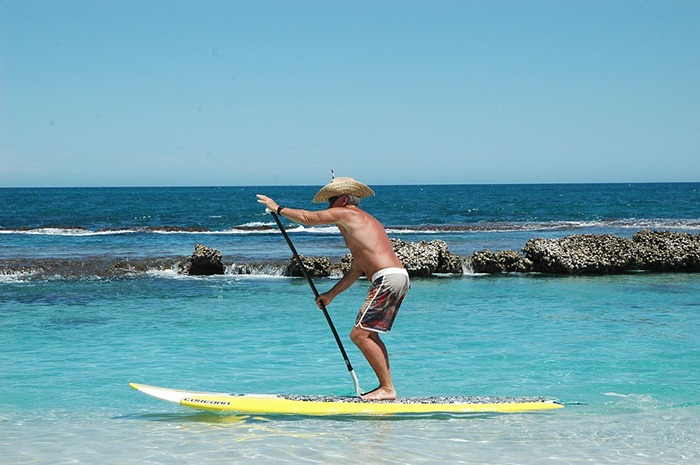Cramping is one of the aspects of stand up paddleboarding that paddlers dread the most. It’s because getting muscle cramp in the water can end a session early and it can also result in a painful wipe-out in the waves as you get caught on the inside, frozen solid with leg cramps. But foot cramps and leg cramps are a natural part of the sport, especially when you’re starting out with it.
According to a popular hypothesis, cramps happen when we exercise vigorously because the muscles seize up when salt, minerals, and electrolytes are lost through sweat. Aside from that, it is also believed that cramping is due to the muscles prematurely fatiguing. This explains why some sports people commonly seize up during the actual activity and not when they are training.
If you commonly experience cramping during your SUP sessions, you no longer have to worry. It’s because there are many ways in which you can limit the chance of suffering from cramps during your SUP sessions. Today, we are going to give you some tips on how to handle cramping while stand up paddleboarding.
When You Experience Cramping While SUP
Here are some of the things that you can do if you happen to experience foot cramps while stand up paddleboarding.
-
Relax Your Feet
Just keep your feet relaxed and do not try to grip the board with your toes. Gripping the board with your toes won’t help and it will just worsen your cramps/
-
Wiggle Your Toes
When you experience cramping while you’re in your SUP session, try to wiggle your toes. You can try to hum a song and then tap your toes to the tune of it. This will get the blood on your feet going and will eventually stop the cramping.
-
Shift Your Weight on the Paddle Board
When you feel your legs or feet cramping, try to shift your weight from the front to the back of your feet. That will also get the blood going and it can also give you even more power in each stroke.
-
Shuffle Around on the Board
Shuffling around on the board will help get the board’s trim right from front-to-back and it will also make turning easier for you when you are suffering from cramping. This will also allow you to ride waves or lift the nose to beach your SUP if you do not want to get your feet wet.
Tips to Prevent Cramping While Stand Up Paddleboarding
We are also giving you some tips on how you can avoid experiencing cramping while stand up paddleboarding.
-
Keep Yourself Hydrated
This is actually a basic tip however it is often overlooked. When we get dehydrated, the fluid around our cells decrease and that causes our muscles to tire, twitch, and cramp. Therefore, by hydrating correctly, the fluids in your body will be at their optimum levels and will run efficiently. It will also limit the chance of experiencing painful spasms while you’re on your SUP session. You can sip small amounts of water often to keep yourself hydrated.
-
Add Salt to Your Diet
Aside from water, salt is also one of the most important minerals for your body to run smoothly. It is a key to maintaining the fluid balances within your body and as well as helping your cell’s ability to absorb and retain water. If you regularly do SUP, then you can add salt tablets to your diet or put some Himalayan salt to your water bottle before your SUP session.
-
Do Some Stretching
Stretching is very important no matter what sport you’re doing, including stand up paddleboarding. Stretching can help in loosening your muscles. It’s because when your muscles are tight, they are more susceptible to cramping, unlike when they are loose and flexible because they are less likely to seize up. Therefore, it’s essential to add stretching to your routine before you start with stand up paddleboarding.
-
Jump Around
Cramping occurs when the small nerves in our muscles start to fatigue. One of the ways to keep these nerves from tiring is by jumping around or which is known as plyometrics. These are jumping exercises that will enable the muscles to exert maximum force in short intervals of time. You can do these exercises after a week of working out to help prevent cramping.
-
Eat Carbohydrates
Depletion of carbohydrate is another factor that can lead to muscle cramps. It’s because carbs are the main fuel used during exercise and once they are all used up, your muscles go into spasms. Therefore, you should also add carbs to your diet if you are going to do SUP a lot.
-
Know Your Limits
Of course, it is very important that you know your limits. It’s because muscles tend to become very twitchy when they become fatigued or injured. If you’re new to SUP, you can limit yourself to shorter periods of time first. Also, becoming fitter and more prepared for the sport will help you decrease the chance of experiencing muscle fatigue and cramps while stand up paddleboarding.
Cramping while stand up paddleboarding can definitely ruin a great session on the water. But by following the tips we shared, you will be able to handle cramping or even avoid it on your next SUP session. If you need more information about stand up paddleboarding, you can check out our post on Guide to the Sport of SUP.

